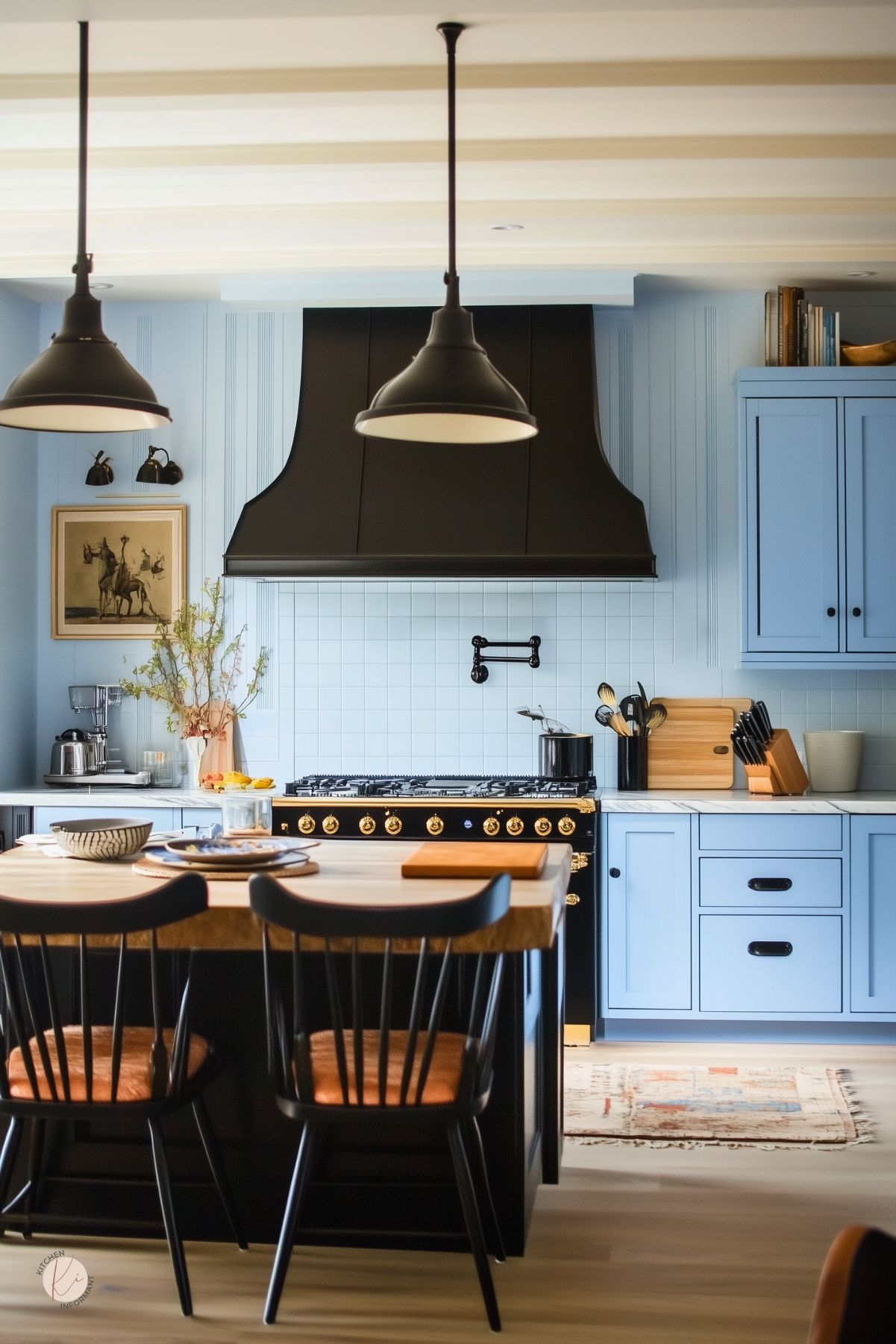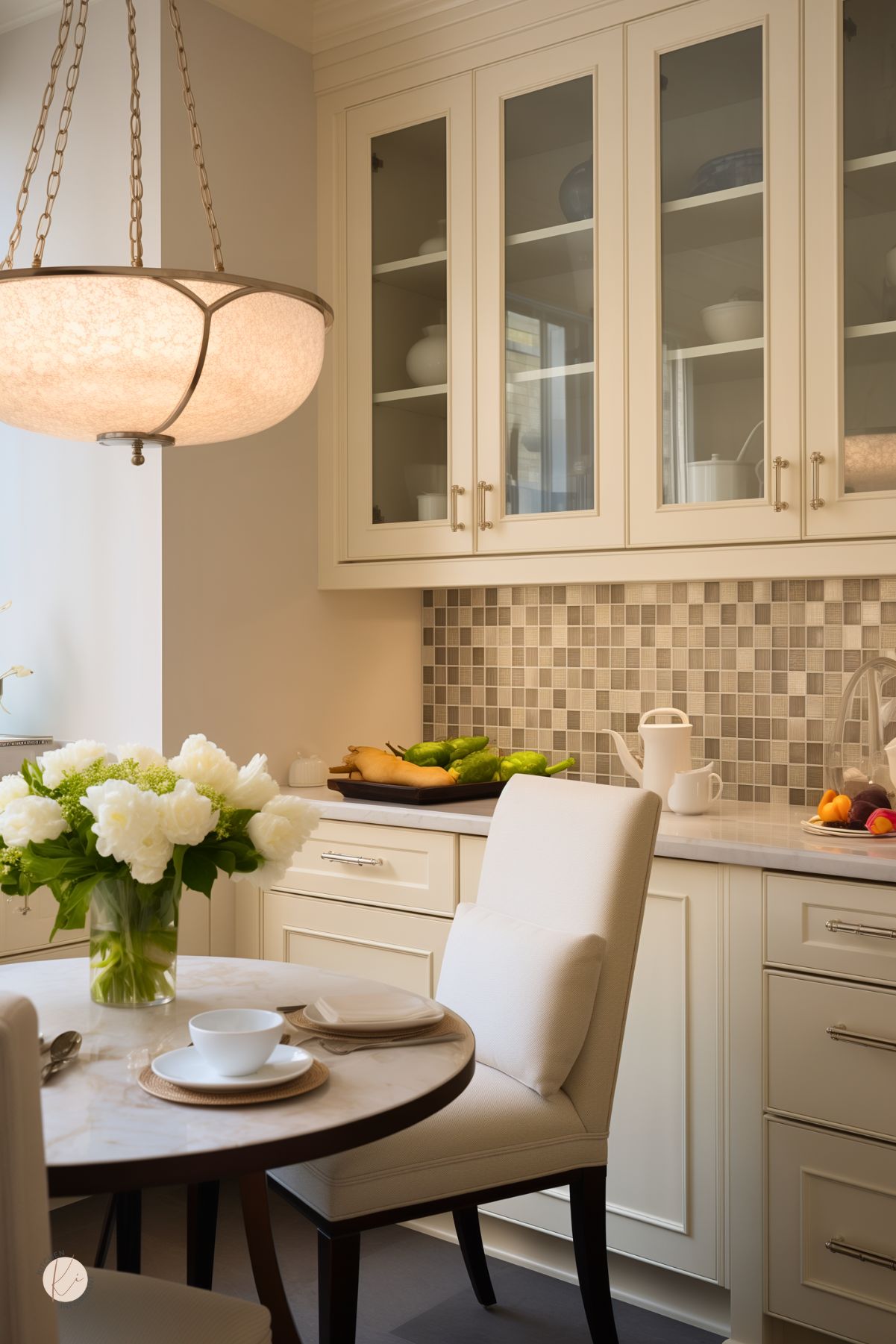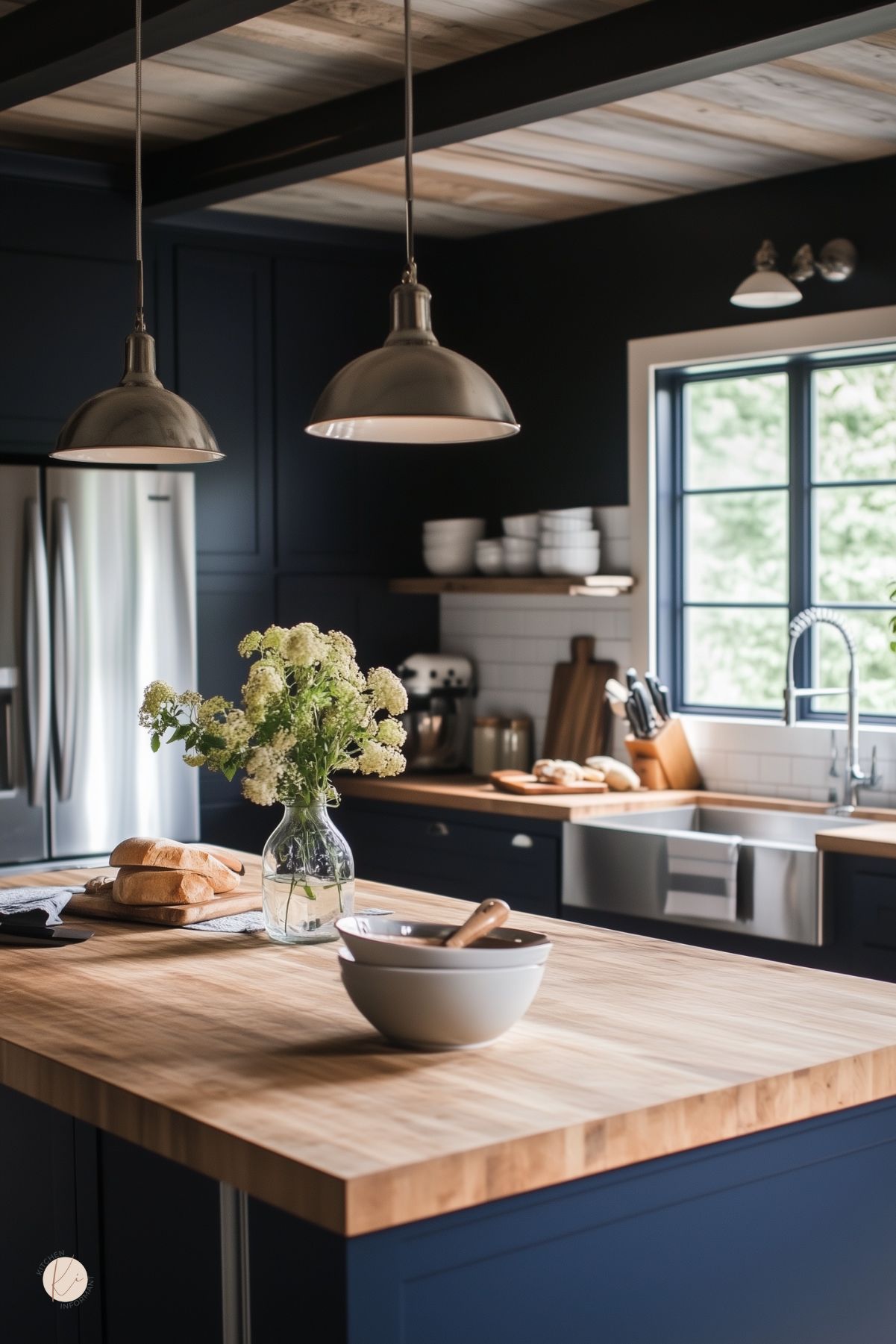Dark hues are making a comeback in kitchen decor. From plum to aubergine, these rich colors are being incorporated into kitchen design in various ways.
We explores the significance of dark hues in kitchen decor, color theory in kitchen design, and strategies for incorporating dark colors into kitchen elements.

Dark colors can add depth, warmth, and sophistication to a kitchen. They can also make a small kitchen feel larger by creating a sense of depth.
However, incorporating dark colors into a kitchen requires careful consideration of color theory.
The right balance of light and dark colors can create a harmonious and inviting space, while the wrong balance can make a kitchen feel gloomy and uninviting.
Key Takeaways
- Dark hues add depth, warmth, and sophistication to a kitchen.
- The right balance of light and dark colors is crucial for a harmonious and inviting space.
- Lighting and material selection are key factors in creating a balanced dark color palette.
The Significance of Dark Hues in Kitchen Decor
Dark hues in kitchen decor have become increasingly popular in recent years. From plum to aubergine, these rich and moody colors add depth and sophistication to any kitchen.
But what is the significance of these dark hues in kitchen decor?
First, dark hues create a sense of drama and elegance in the kitchen. They add a touch of luxury and sophistication that is hard to achieve with lighter colors.
Dark hues also create a cozy and intimate atmosphere, making the kitchen a welcoming space for cooking and entertaining.
Another significance of dark hues in kitchen decor is their versatility. These colors can be paired with a wide range of materials and finishes, from natural wood to sleek metal.
They also work well with a variety of styles, from traditional to modern.
When it comes to choosing the right dark hue for your kitchen, it’s important to consider the overall style and mood you want to create.
Plum and aubergine are great choices for a moody and dramatic look, while darker shades of blue and green can create a serene and calming atmosphere.
In summary, the significance of dark hues in kitchen decor lies in their ability to create a sense of drama and elegance, their versatility, and their ability to set the mood for the space.
When used correctly, these colors can transform any kitchen into a sophisticated and welcoming space.
Color Theory in Kitchen Design

When it comes to designing a kitchen, color plays a significant role in setting the tone and atmosphere.
Dark hues, such as plum and aubergine, are becoming increasingly popular in kitchen decor.
Understanding color psychology and complementary colors is essential to create a cohesive and visually appealing space.
Understanding Color Psychology
Color psychology is the study of how colors affect human behavior and emotions. Dark colors, such as plum and aubergine, are associated with sophistication, elegance, and luxury.
These colors can create a cozy and intimate atmosphere, perfect for a kitchen.
However, it is important to note that dark colors can also make a space feel smaller and more confined. To avoid this, it is recommended to balance dark colors with lighter shades and natural light.
Complementary Colors for Dark Kitchens
Complementary colors are colors that are opposite each other on the color wheel. When used together, they create a visually pleasing contrast.
For dark kitchens, complementary colors can add depth and balance to the space.
One complementary color for aubergine is mustard yellow. This color combination creates a visually interesting pairing, as seen in this kitchen design article.
Another complementary color for plum is green, which can add a natural and refreshing element to the space.
Understanding color psychology and complementary colors is crucial when designing a kitchen with dark hues.
By incorporating these principles, one can create a visually appealing and cohesive space that reflects their personal style.
From Plum to Aubergine: Defining the Spectrum

Characteristics of Plum
Plum is a rich, warm, and sophisticated hue that falls on the darker end of the purple spectrum. It is a versatile color that can be paired with a range of other colors to create different moods and styles.
Plum is often associated with luxury and elegance and can add a touch of glamour to any space.
Plum has a complex undertone that can vary depending on the lighting and surrounding colors. It is a blend of red and blue hues, with a touch of brown that gives it a warm and earthy feel.
Plum can be a challenging color to work with, but when done right, it can create a stunning and inviting space.
Characteristics of Aubergine
Aubergine is a deep and moody shade of purple that is often used in interior design to create a dramatic and sophisticated look.
It is a complex color that can be difficult to define, but it is generally darker and more subdued than plum.
Aubergine is a versatile color that can be paired with a range of other colors to create different moods and styles.
Aubergine is a blend of red and blue hues, with a touch of gray that gives it a muted and sophisticated feel.
It is a rich and intense color that can add depth and dimension to any space. Aubergine is often associated with luxury and elegance and can create a sense of drama and intrigue.
When used in kitchen decor, it can add a touch of sophistication and glamour to the space.
Incorporating Dark Hues into Kitchen Elements

Dark hues can add depth and sophistication to any kitchen decor.
Here are some ways to incorporate dark hues into different kitchen elements:
Cabinetry and Dark Color Schemes
One of the most popular ways to incorporate dark hues into a kitchen is through cabinetry. Dark-colored cabinets can add a sense of drama to the space, while still remaining practical and functional.
A popular color scheme is aubergine, which is a deep, rich purple color. This color pairs well with other dark hues, such as black or dark gray, and can be balanced out with lighter countertops and backsplashes.
Another popular color scheme is a plum, which is a darker shade of purple with more red undertones.
This color can be paired with lighter wood tones or white countertops and backsplashes for a more balanced look.
Countertops and Backsplashes
Dark countertops and backsplashes can also add depth and contrast to a kitchen. Black granite or quartz countertops can create a sleek and modern look, while a dark tile backsplash can add texture and interest to the space.
A popular backsplash option is aubergine-colored subway tile, which can add a pop of color without being too overwhelming.
Appliances and Accessories
For those who want to incorporate dark hues into their kitchen decor in a more subtle way, appliances and accessories are a great option.
Stainless steel appliances with black accents can add a touch of sophistication to any kitchen, while black or aubergine-colored small appliances, such as toasters or coffee makers, can add a pop of color to the countertop.
Dark-colored kitchen towels, rugs, or even dishware can also add a touch of elegance to the space.
When incorporating dark hues into a kitchen, it’s important to balance them out with lighter elements to prevent the space from feeling too overwhelming.
By incorporating dark hues into different kitchen elements, homeowners can create a space that is both functional and stylish.
Lighting Strategies for Dark Kitchens

Dark kitchens can look stunning when decorated correctly. However, they can also feel gloomy and uninviting if not appropriately lit.
Here are some lighting strategies to consider when designing a dark kitchen.
Natural Light Maximization
One of the simplest ways to brighten up a dark kitchen is to maximize natural light. If possible, avoid blocking natural light with window treatments. Instead, allow as much natural light to pour in as possible.
If privacy is a concern, consider using sheer curtains or blinds that can be easily opened and closed.
Another way to maximize natural light is to use reflective surfaces. Mirrors, glossy tiles, and stainless steel appliances can all help to reflect natural light, making the kitchen feel brighter and more spacious.
Artificial Lighting Considerations
In addition to natural light, artificial lighting is also essential in a dark kitchen. Here are some lighting considerations to keep in mind:
- Overhead Lighting: Multiple recessed ceiling lights spaced out evenly can provide uniform brightness throughout the kitchen. Pendant lights can also work well over islands and dining areas.
- Task Lighting: Under-cabinet lighting is perfect for countertop task areas. LED strips are a useful option for providing additional illumination.
- Accent Lighting: Accent lighting can help to create a warm and inviting atmosphere in a dark kitchen. Consider using LED strip lights to highlight architectural features, artwork, or decorative elements.
When selecting light fixtures, it’s essential to consider the color temperature of the bulbs.
Bulbs with a warm color temperature (around 2700K) can help to create a cozy and inviting atmosphere, while bulbs with a cooler color temperature (around 5000K) can provide bright and energizing light.
By following these lighting strategies, a dark kitchen can be transformed into a beautiful and inviting space.
Material Selection for Dark Color Palettes

When designing a kitchen with dark color palettes, selecting the right materials is crucial to achieving the desired look and feel.
Here are some options to consider:
Natural Materials
Natural materials such as wood, marble, and granite can add warmth and texture to a dark kitchen. Dark wood cabinets paired with a light marble countertop can create a striking contrast that is both elegant and timeless.
Similarly, a dark granite countertop can add depth and richness to a kitchen with dark cabinets.
Synthetic and Composite Materials
Synthetic and composite materials such as quartz and laminate can offer a more affordable alternative to natural materials while still achieving the desired look.
Quartz countertops, for example, can mimic the look of natural stone while being more durable and resistant to stains.
Laminate cabinets can also provide a budget-friendly option for achieving a dark color palette in the kitchen.
When selecting materials for a dark color palette, it’s important to consider both the aesthetic and practical aspects of each option.
Natural materials may offer a more luxurious look but may require more maintenance, while synthetic and composite materials may be more durable but may not have the same level of visual appeal.
Ultimately, the choice will depend on the individual’s preferences and budget.
Accent Colors and Textures in Dark Kitchens

Dark kitchens can be intimidating to decorate, but with the right accent colors and textures, they can be transformed into a cozy and inviting space.
Here are some ideas to consider:
Metallic Accents
Metallic accents can add a touch of glamour to dark kitchens. Gold, silver, and copper are popular choices that can be incorporated in various ways.
For example, gold or copper light fixtures can add warmth and shine to the space. Silver or chrome handles and knobs can provide a sleek and modern touch.
Additionally, stainless steel appliances can complement dark cabinetry and create a cohesive look.
Textural Contrasts
Textural contrasts can add depth and interest to dark kitchens. For example, a natural stone backsplash can provide a rugged and earthy feel that contrasts well with dark cabinetry.
A wooden countertop or butcher block can add warmth and texture to the space. Additionally, a patterned rug or curtains can provide a pop of color and pattern that complements the dark hues.
Metallic accents and textural contrasts are two ways to add interest and personality to dark kitchens.
By incorporating these elements, a dark kitchen can be transformed into a cozy and inviting space that is both stylish and functional.
Maintaining Balance with Dark Kitchen Decor

Dark hues in kitchen decor can add a touch of elegance and sophistication to any space. However, it’s important to maintain balance when using these colors to avoid creating a space that feels overwhelming or too dark.
Here are some tips for maintaining balance with dark kitchen decor:
Spatial Dynamics
When designing a kitchen with dark decor, it’s important to consider the spatial dynamics of the room.
Dark colors can make a space feel smaller and more enclosed, so it’s important to balance them with lighter colors and materials to create a sense of openness.
One way to achieve this balance is by using light-colored countertops, backsplashes, and flooring to offset the darker colors of the cabinets and walls.
Another option is to incorporate natural light into the space through windows or skylights to brighten up the room and create a sense of openness.
Color Distribution
Another key factor in maintaining balance with dark kitchen decor is color distribution. Too much of one color can make a space feel monotonous and dull, so it’s important to incorporate a variety of colors and textures to add depth and interest to the room.
One way to achieve this is by using different shades of the same color throughout the space. For example, aubergine cabinets paired with lighter plum walls can create a cohesive look while still providing contrast and interest.
Another option is to incorporate complementary colors into the space, such as gold or brass accents to add warmth and shine. A mix of textures, such as a glossy backsplash paired with matte cabinets, can also add visual interest and depth to the space.
Maintaining balance with dark kitchen decor is all about creating a sense of harmony and cohesion throughout the space.
By considering the spatial dynamics of the room and incorporating a variety of colors and textures, you can create a kitchen that feels elegant and sophisticated without feeling too dark or overwhelming.
Frequently Asked Questions

How can I incorporate aubergine hues into my kitchen color scheme?
Incorporating aubergine hues into a kitchen color scheme can be done in several ways. One option is to use aubergine as an accent color by incorporating it into small details such as kitchen towels, dishware, or even a backsplash. Another option is to use aubergine as the dominant color by painting the walls or cabinets with this rich, dark hue.
What complementary colors pair well with dark plum shades in kitchen design?
When it comes to complementary colors for dark plum shades in kitchen design, neutral colors such as white, gray, and beige can help balance out the richness of the plum. Other complementary colors that pair well with plum include gold, copper, and green. These colors can be incorporated through kitchen accessories, such as light fixtures, hardware, or kitchen appliances.
Is aubergine considered a suitable choice for small kitchen spaces?
Aubergine can be a suitable choice for small kitchen spaces, but it is important to balance the dark color with lighter elements to avoid making the space feel cramped or gloomy. One way to incorporate aubergine in a small kitchen is to use it as an accent color, rather than the dominant color. For example, aubergine can be used for small details such as a rug, curtains, or decorative items, while keeping the walls and cabinets light.
What lighting options enhance dark-colored kitchens?
Lighting is crucial in enhancing dark-colored kitchens. Installing under-cabinet lighting can help illuminate countertops and create a warm, inviting atmosphere. Pendant lights or chandeliers can also be used as statement pieces to highlight the space and draw the eye upwards.
How do I balance dark kitchen decor to avoid an overly gloomy atmosphere?
To balance dark kitchen decor and avoid an overly gloomy atmosphere, it is important to incorporate lighter elements such as white or light-colored countertops, backsplashes, or flooring. Another way to balance the dark hues is by adding natural light through windows or skylights. Additionally, using reflective surfaces such as glass or mirrors can help bounce light around the space and create a brighter ambiance.





